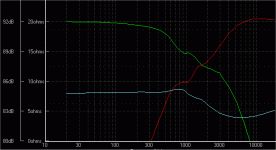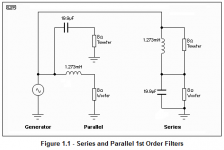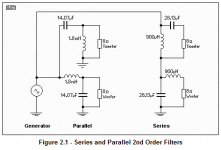Series crossovers are such highly optimised things that it makes you think very clearly about a lot of issues in selecting suitable drivers and component values.
I think it's more accurate to probably say that Series crossovers have such limitations that they require you to pick certain drivers so that they could ever stand the chance of working properly.
The problem I have with this discussion, other than its being little more than a history lesson, is the pointing to a simple, resistively loaded LC seres crossover as an example of "the math" and then pointing to something like the AR 48s as a typical implimentation. The two are rather far apart. The resistively loaded LC crossover is a constant voltage system, but in something like the AR 48s the sum of the voltages across the driver terminals is not 1.0. It is not constant voltage.
5th elements commets are quite correct.
5th elements commets are quite correct.
It's really quite an honour to have so many series crossover alumni hanging in this thread. 🙂
I really don't think you can criticise my contributions here. I've been more analytic and on-topic than most. I posted the Acoustic Research circuit for sreten's benefit since he was stymied by bafflestep correction. The maths is essential to see the midrange contribution the simple first order series circuits add so efficiently. The secret sauce, if you like, though I notice much the same thing can be done electrically with an inefficient parallel circuit design.
In fact I have found Edward Norton's 1928 constant resistance filters most useful in getting a grip on all this:
http://www.diyaudio.com/forums/multi-way/206843-sreten-speakerman-go-series-xos-4.html#post2909474
It's not too hard to calculate the values for 2nd and 3rd order series crossovers using his techniques. Because the higher order filters look far more practical. Very simple and elegant result! Progress. Just have to see what they do to the transfer function. 😉
I really don't think you can criticise my contributions here. I've been more analytic and on-topic than most. I posted the Acoustic Research circuit for sreten's benefit since he was stymied by bafflestep correction. The maths is essential to see the midrange contribution the simple first order series circuits add so efficiently. The secret sauce, if you like, though I notice much the same thing can be done electrically with an inefficient parallel circuit design.
In fact I have found Edward Norton's 1928 constant resistance filters most useful in getting a grip on all this:
http://www.diyaudio.com/forums/multi-way/206843-sreten-speakerman-go-series-xos-4.html#post2909474
It's not too hard to calculate the values for 2nd and 3rd order series crossovers using his techniques. Because the higher order filters look far more practical. Very simple and elegant result! Progress. Just have to see what they do to the transfer function. 😉
Last edited:
Hmmm ......
Take a simple 1st order electrical parallel filter with the bass inductor
oversized for baffle step, i.e. electrically its thoroughly assymetrical.
Make some reasonable assumptions such that it works OK.
(the actual acoustic x/o function isn't necessarily 1st order....)
Try coming up with an equivalent 1st order electrical series x/o, you can't .....
You cannot say that they are the same, or that they are equivalent.
Simple series x/o's have their practical uses and with real drivers behave
differently to simple parallel filters. The theory is largely redundant when
you look at practical usage and the real resulting acoustic x/o functions.
e.g. look at parallel versus series for a passive 1st order sub/sat system.
Consider how the sats bass impedance peak interacts with both filters ....
Consider how the subs inductance interacts with both types of filters ....
There is a very good chance series will be "better" than parallel ....
Do the same for electrical 2nd order series and parallel fiters ....
rgds, sreten.
Take a simple 1st order electrical parallel filter with the bass inductor
oversized for baffle step, i.e. electrically its thoroughly assymetrical.
Make some reasonable assumptions such that it works OK.
(the actual acoustic x/o function isn't necessarily 1st order....)
Try coming up with an equivalent 1st order electrical series x/o, you can't .....
You cannot say that they are the same, or that they are equivalent.
Simple series x/o's have their practical uses and with real drivers behave
differently to simple parallel filters. The theory is largely redundant when
you look at practical usage and the real resulting acoustic x/o functions.
e.g. look at parallel versus series for a passive 1st order sub/sat system.
Consider how the sats bass impedance peak interacts with both filters ....
Consider how the subs inductance interacts with both types of filters ....
There is a very good chance series will be "better" than parallel ....
Do the same for electrical 2nd order series and parallel fiters ....
rgds, sreten.
Last edited:
If you want to take two poles and cover them with an asymptotic equivalent, this will only be correct for a single case. The same could be said about making use of the driver's acoustic response. It needs to come back a step to remain valid.Take a simple 1st order electrical parallel filter with the bass inductor
oversized for baffle step, i.e. electrically its thoroughly assymetrical.
Make some reasonable assumptions such that it works OK.
(the actual acoustic x/o function isn't necessarily 1st order....)
This plot is for illustrative purposes only.
Attachments
One word of advice with inductors. Air core a must and doing a subwoofer with true sub drivers will be expensive using 8 ohm drivers.
14-10 gauge wire is required . Most subs need to be padded down a little to mate with satellites.
I am sure Jerry at Falcon can supply U.K. users with any value needed.
Solen has the best price in North America for Canadian and U.SA. builders.
Back in the early 90's Solen was the only vendor I could find that had 12mh 14 gauge air core inductors.
14-10 gauge wire is required . Most subs need to be padded down a little to mate with satellites.
I am sure Jerry at Falcon can supply U.K. users with any value needed.
Solen has the best price in North America for Canadian and U.SA. builders.
Back in the early 90's Solen was the only vendor I could find that had 12mh 14 gauge air core inductors.
Hi,
#365
Yes you can add BSC to a 1st order series but only by adding
what is effectively an additional parallel 6dB step section to it all.
This arrangement needs a tweeter the same half space sensitivity
as the bass / mid unit unlike the below, still nobbled by 6dB though.
#366
Nobbling one driver by 6dB goes back to the FAST arrangement I
described earlier with the lower driver 6dB more efficient than the
other, x/o around the baffle step frequency.
rgds, sreten.
You can't implement a 2 component series equivalent of
a highly assymetric 2 component parallel crossover.
Cored inductors do what they say on the tin, despite protestations
to the contrary, very much like valve amplifier output transformers.
#365
Yes you can add BSC to a 1st order series but only by adding
what is effectively an additional parallel 6dB step section to it all.
This arrangement needs a tweeter the same half space sensitivity
as the bass / mid unit unlike the below, still nobbled by 6dB though.
#366
Nobbling one driver by 6dB goes back to the FAST arrangement I
described earlier with the lower driver 6dB more efficient than the
other, x/o around the baffle step frequency.
rgds, sreten.
You can't implement a 2 component series equivalent of
a highly assymetric 2 component parallel crossover.
Cored inductors do what they say on the tin, despite protestations
to the contrary, very much like valve amplifier output transformers.
Last edited:
As john k pointed out in #353...so we add to it, making a hybrid. Then we apply the conjugate to the extras, as I assume would be the preferred way.You can't implement a 2 component series equivalent of a highly assymetric 2 component parallel crossover.
What's the harm in it? Although given that the complexity is rising the question ought to be: What's good about it. If I took the liberty of applying a crossover Zin conjugate to a // filter I'd have the optimum acoustic response and I'd have a resistive looking speaker.
Attachments
One word of advice with inductors. Air core a must and doing a subwoofer with true sub drivers will be expensive using 8 ohm drivers.
The size of the parts if you are trying to XO below 200 Hz or so, makes it pretty easy to justify bi-amplification -- a common upgrade we did with Fried H & M.
dave
What's the harm in it? Although given that the complexity is rising the question ought to be: What's good about it.
Indeed.
The question isn't whether it can be made to work in some cases but whether series connected networks have any advantages that would override the difficulties.
I still don't see why any network configuration that kills the independance between sections inherent in parallel, low Z driven networks, should be pursued. That is, unless you want a perverse audiophile challenge.
Inevitable driver impedance phenomena of one driver show up in the voltage drive of the other. Woofer heating changes tweeter drive? Can't tweak tweeter network without changing woofer network. Can't design one section to fit a target curve, then move on to the next one. Need to worry about production variation (impedance curve variation) showing up in opposite sections. Need to add mandatory conjugation to make it work.
What were the pluses?
David S.
What were the pluses?
If you really can't build speakers, you can get away with series ones.
Back in the early 80's many companies that sold raw drivers with limited specs suggested using a 15ohm Re in parallel of the tweeter in 6db per octave crossovers to flatten tweeter impedance.
In a design with 4ohm drivers a 10 ohm Re would be used in parallel of the tweeter.
I am pretty sure it was written on the box of Dynaudio D-28 H where I previously stated. Dynaudio suggested 6db per octave crossovers be used and suggested a 15ohm Re be used in parallel of the tweeter.
Planet10 still might have one of the boxes?
In a design with 4ohm drivers a 10 ohm Re would be used in parallel of the tweeter.
I am pretty sure it was written on the box of Dynaudio D-28 H where I previously stated. Dynaudio suggested 6db per octave crossovers be used and suggested a 15ohm Re be used in parallel of the tweeter.
Planet10 still might have one of the boxes?
Yup, back in the 'ol' days. I still have a 1994 Solen Cat. with Dynaudio D-28 specs. Fs=700 hz, nom power handling 300W, music 1200W 😱 transient 1000W 😱
Can you find me a DIY dome tweeter today with similar specs? If not, then you should stop 'reminiscing' and deal with reality (i.e. the present) in discussing dome tweeters in series circuits.
Can you find me a DIY dome tweeter today with similar specs? If not, then you should stop 'reminiscing' and deal with reality (i.e. the present) in discussing dome tweeters in series circuits.
Speakerdoctor the catalog I was referring to was from 1980 Transcendental Audio in CO. Audio Concepts also mentions it in their driver catalog in early in 1990's The D-28H is not the same as the D-28.
I prefer the Hiquphon 2092Fs
There are many Scan Speak and Morel tweeters that can take the same power as the D-28.
The laws of physica have not changed.
I prefer the Hiquphon 2092Fs
There are many Scan Speak and Morel tweeters that can take the same power as the D-28.
The laws of physica have not changed.
The Morel ET 338 have the specs Speakerdoctor is looking for.
Always glad to help.
Morel ET 338 1-1/8" Soft Dome Tweeter Matched Pair 277-070
Mikiel Shabani is under liscense to make Dynaudio clones.
If you have a tweeter that needs repaired I can highly refer you to this link.
miller2
Always glad to help.
Morel ET 338 1-1/8" Soft Dome Tweeter Matched Pair 277-070
Mikiel Shabani is under liscense to make Dynaudio clones.
If you have a tweeter that needs repaired I can highly refer you to this link.
miller2
Last edited:
Back in the early 80's many companies that sold raw drivers with limited specs suggested using a 15ohm Re in parallel of the tweeter in 6db per octave crossovers to flatten tweeter impedance.
It does help, but only so much. This plot shows an ideal two element series crossover at 1kHz. The woofer has an ideal flat response and impedance. The tweeter has an ideal flat response, but real tweeter impedance data (SS dome) with a 10 ohm resistor across it. (Shows responses and Ztotal)
Attachments
Indeed.
The question isn't whether it can be made to work in some cases but whether series
connected networks have any advantages that would override the difficulties.
What were the pluses?
David S.
Hi,
Repeat mode :
Model 1st order series versus 1st order parallel with real drivers
with inductance and with a Fs resonant peak for the higher driver.
There are differences that can be regarded as pluses in some cases.
The low pass is quasi second order for series due to the bass drivers
inductance, the same inductance that causes 1st order parallel low
pass to be a shelving circuit, not a 1st order roll-off. Look at the
excitation / damping of the high pass units fundamental resonance.
rgds, sreten.
Last edited:
Hi,
Repeat mode :
Model 1st order series versus 1st order parallel with real drivers
with inductance and with a Fs resonant peak for the higher driver.
There are differences that can be regarded as pluses in some cases.
The low pass is quasi second order for series due to the bass drivers
inductance, the same inductance that causes 1st order parallel low
pass to be a shelving circuit, not a 1st order roll-off. Look at the
excitation / damping of the high pass units fundamental resonance.
rgds, sreten.
Maybe thats the problem, I'm just not a first order network guy. I tried messing around in PCD and can't get past the fact that the woofer lowpass and tweeter highpass are tied together. Every change to one forces a change in the other. The amount of overlap seems fixed and that makes it difficult to hit a good shape from the combined sections.
I won't deny that some may achieve fine results but it seems very constraining. A bit like "let's see if we can exactly mimic some Picasso sketches...left handed".
My approach is working backwards from the desired end result. Define the desired total acoustic response of woofer and tweeter sections. Subtract the starting raw driver response from that to define the desired electrical filter response. Infer a topology that will give that response, and optimize values to get there.
I can do that with parallel networks. Never with series networks.
David S.
While the series haters continue to kvetch (and God knows I wish they'd shut up!), I have been doing more work on a very precisely valued second order series crossover, Mr. speakerman19422! 🙂
Very interesting findings. The transfer function and impedance is really VERY unique. 😎
Get loose on these circuits with pure 8 ohm resistances rather than real-world drivers, AllenB!
Very interesting findings. The transfer function and impedance is really VERY unique. 😎
Get loose on these circuits with pure 8 ohm resistances rather than real-world drivers, AllenB!
Attachments
- Status
- Not open for further replies.
- Home
- Loudspeakers
- Multi-Way
- Sreten & Speakerman go at series XOs





